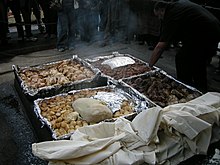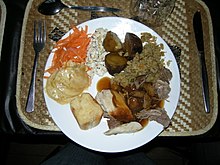Hāngī(Māori:[ˈhaːŋiː]) is a traditionalNew ZealandMāorimethod of cooking food using heated rocks buried in apit oven,called anumu.[1]It is still used for large groups on special occasions, as it allows large quantities of food to be cooked without the need for commercial cooking appliances.[2]



Process
editTo "lay a hāngī" or "put down a hāngī" involves digging a pit in the ground, heating stones in the pit with a large fire, placing baskets of food on top of the stones, and covering everything with earth for several hours before uncovering (or lifting) the hāngī.[3]Hāngī experts have developed and improved methods that have often, like the stones themselves, been handed down for generations.
Common foods cooked in a hāngī are meats such as lamb, pork, chicken and seafood (kaimoana), and vegetables such as potato,kūmara(sweet potato),yams(oca), pumpkin, squash, taro and cabbage.[4][5][6]
A hāngī pit is dug to a depth of between 50–100 cm (20–40 in), sufficient to hold the rocks and two stacked baskets of food. Logs, usuallymānukaorkānuka,are stacked over the pit with the rocks, commonlyandesiteorbasalt,on top. The logs are lit and is left to burn for 3 to 4 hours, heating the rocks to 600–700 °C (1,100–1,300 °F). Once the fire has burned down, the hot embers and most of the ash is removed. Alternatively, the fire is built separately and the hāngī pit is dug while the fire is burning, with the hot rocks transferred to the pit after heating.[4][5]
Meanwhile, the food is prepared and placed in wire baskets lined with eitherpuka,banana or cabbage leaves, or aluminium foil. The meat basket is placed in the bottom of the pit, with the vegetable basket placed on top. If seafood is included, it is placed on top of the vegetable basket. Wet sacks or cloth are placed on top of the baskets, and the whole pit is covered with earth. The hāngī takes approximately 2.5 to 4 hours to cook. A person supervises the hāngī while it cooks, covering up any escaping steam with earth.[4][5][6]
Once the hāngī is cooked, the earth is carefully removed from the top of the pit, followed by the sacks or cloth. The baskets are lifted out of the pit, and the food taken to the kitchen for carving and serving.[4][5]
Prior to colonisation and the introduction of metals and wire, food was laid between bark, large leaves and other vegetation. Wire baskets became widely used in the early 19th century, with sacking and cloth replacing leaves and bark as the covering of choice.[7]
In the early 21st century, gas-heated stainless-steel "hāngī machines" are sometimes used to replicate the style of cooking without the need for a wood fire, rocks and a pit.[8]
Earlyumu-tī
editEvidence fromearly Polynesiansettler sites in New Zealand such asWairau Barand in coastalOtago Peninsulafrom about 1280 shows a significant number of large cooking pits orumuwhich were designed to cooktī kōukaor various other species ofCordyline.[7]
The distinguishing feature of anumu-tīwas its large size compared to a normal earth oven. The long, carrot-shaped tap root was cooked in a large, stone-lined pit for between one and two days. The result was a fibrous mass of sweet pulp with a bitter aftertaste. This was a common east Polynesian practice in theCook IslandsandSociety Islands,[9]and the remains of largeumuhave also been found in theKermadec Islands.Investigation inOtagoshows that most of these pits were used only once or twice.[citation needed]
See also
editReferences
edit- ^"umu".Maori Dictionary.Te Aka Online Māori Dictionary.Retrieved9 November2018.
- ^Satyanand, Anand (17 January 2010)."Hangi for Prince William".The Governor-General.Retrieved9 November2018.
- ^Industries, Ministry for Primary."He whakatairanga i ngā ahuatanga mahi mō te tunu hāngi: Food safety practices in preparing and cooking a hāngi".New Zealand Food Safety.Retrieved9 November2018.
- ^abcd"Make your own hāngī".Māori Television.Retrieved4 May2021.
- ^abcdHe whakatairanga i ngā ahuatanga mahi mō te tunu hāngi = Food safety practices in preparing and cooking a hāngi.New Zealand. Ministry for Primary Industries. [Wellington, N.Z.] 2013.ISBN978-0-478-41430-1.OCLC891789073.
{{cite book}}:CS1 maint: location missing publisher (link) CS1 maint: others (link) - ^ab"Māori hāngī | 100% Pure New Zealand".newzealand.Retrieved4 May2021.
- ^ab"The New Zealand Maori Hangi: Foods, Preparations and Methods Used".Genuine Maori Cuisine.Epuro Hands International Limited. 2005.Retrieved2 October2012.
- ^"About the MultiKai Cooker".Multi KC Ltd. 2011.Retrieved2 October2012.
- ^Knight, Hardwicke (1966)."Umu-ti".The Journal of the Polynesian Society.75(3): 332–347.Retrieved9 November2018.